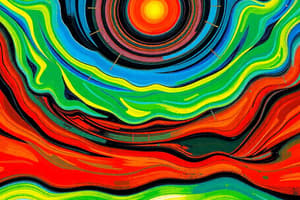Podcast
Questions and Answers
Which air mass is characterized by high humidity and originates over warm ocean waters?
Which air mass is characterized by high humidity and originates over warm ocean waters?
- cP (Continental Polar)
- cT (Continental Tropical)
- mP (Maritime Polar)
- mT (Maritime Tropical) (correct)
What is the primary lifting mechanism that occurs when air converges at a low-pressure area?
What is the primary lifting mechanism that occurs when air converges at a low-pressure area?
- Orographic Lifting
- Frontal Lifting
- Convective Lifting
- Convergent Lifting (correct)
Which type of front is depicted with a line that has semi-circles on one side?
Which type of front is depicted with a line that has semi-circles on one side?
- Cold Front
- Occluded Front
- Stationary Front
- Warm Front (correct)
In which stage of a midlatitude cyclone does the storm system begin to weaken and lose its defined characteristics?
In which stage of a midlatitude cyclone does the storm system begin to weaken and lose its defined characteristics?
Which of the following processes describes how greenhouse gases change global temperatures?
Which of the following processes describes how greenhouse gases change global temperatures?
Which tool is primarily used for monitoring atmospheric conditions at higher altitudes?
Which tool is primarily used for monitoring atmospheric conditions at higher altitudes?
Which of the following proxy records can indicate past climate conditions by examining tree growth patterns?
Which of the following proxy records can indicate past climate conditions by examining tree growth patterns?
What distinguishes a super-cell thunderstorm from other types?
What distinguishes a super-cell thunderstorm from other types?
Which climatic region is characterized by warm temperatures year-round and minimal seasonal variation?
Which climatic region is characterized by warm temperatures year-round and minimal seasonal variation?
What are the two main causes of sea level rise as the climate warms?
What are the two main causes of sea level rise as the climate warms?
Which characteristic of Earth's orbit do the Milankovitch cycles describe?
Which characteristic of Earth's orbit do the Milankovitch cycles describe?
Which climate type predominantly features high temperatures, a seasonal monsoon influence, and heavy rainfall during specific months?
Which climate type predominantly features high temperatures, a seasonal monsoon influence, and heavy rainfall during specific months?
Which of the following greenhouse gases has the highest concentration in the atmosphere?
Which of the following greenhouse gases has the highest concentration in the atmosphere?
Which of the following pairs correctly describes the two carbon cycles on Earth?
Which of the following pairs correctly describes the two carbon cycles on Earth?
What is a defining feature of the Keeling Curve?
What is a defining feature of the Keeling Curve?
Which of the following best defines positive feedback mechanisms in climate systems?
Which of the following best defines positive feedback mechanisms in climate systems?
Flashcards
mP air mass
mP air mass
Maritime Polar air mass; forms over cold ocean; brings cool, moist air.
Convective Lifting
Convective Lifting
Warm, moist air rises due to its buoyancy.
Orographic Lifting
Orographic Lifting
Air forced to rise over a mountain range.
Midlatitude Cyclone Lifecycle
Midlatitude Cyclone Lifecycle
Signup and view all the flashcards
Tropical Climate
Tropical Climate
Signup and view all the flashcards
Mesothermal Climate
Mesothermal Climate
Signup and view all the flashcards
Microthermal Climate
Microthermal Climate
Signup and view all the flashcards
Tropical Cyclone
Tropical Cyclone
Signup and view all the flashcards
Greenhouse Gas Effect
Greenhouse Gas Effect
Signup and view all the flashcards
Milankovitch Cycles
Milankovitch Cycles
Signup and view all the flashcards
Positive Feedback (Climate)
Positive Feedback (Climate)
Signup and view all the flashcards
Negative Feedback (Climate)
Negative Feedback (Climate)
Signup and view all the flashcards
Sea Level Rise (Causes)
Sea Level Rise (Causes)
Signup and view all the flashcards
Keeling Curve
Keeling Curve
Signup and view all the flashcards
Proxy Records of Climate
Proxy Records of Climate
Signup and view all the flashcards
Greenhouse Gas Characteristics
Greenhouse Gas Characteristics
Signup and view all the flashcards
Study Notes
Chapter 7 Weather
- Be able to describe air masses impacting North America, including temperature and humidity characteristics and source regions.
- mP (Maritime Polar)
- CP (Continental Polar)
- mT (Maritime Tropical)
- CT (Continental Tropical)
- Be able to describe 4 lifting mechanisms.
- Convergent Lifting
- Convective Lifting
- Orographic Lifting
- Frontal Lifting
- Understand windward and leeward precipitation patterns around mountains.
- Know how warm and cold fronts cause lifting, and the types of clouds/precipitation associated.
- Identify symbols on weather maps for warm, cold, occluded, and stationary fronts.
- Know the stages in a midlatitude cyclone's lifecycle.
- Cyclogenesis
- Open Stage
- Occluded Stage
- Dissolving Stage
- Be able to describe weather monitoring and forecasting tools.
- Ground stations (ASOS)
- Weather Balloons
- Weather Satellites (GOES)
- RADAR
- Be able to describe thunderstorm types.
- Single-Cell (pop-up/air mass)
- Squall Lines
- Super-Cell (rotating)
- Know the scale used to rate tornado strength.
- Be able to describe differences between tropical and midlatitude cyclones.
- Tropical cyclones do not have warm or cold fronts since they do not involve cold air masses.
Chapter 9 Climate Regions
- Be able to describe the 5 major climate classes.
Chapter 10 Climate Change
- Be able to describe how greenhouse gases act to change global temperatures.
- Be able to describe how proxy records relate to changes in climate.
- Tree rings
- Ice cores
- Sediment cores
- Be able to name major geologic events that cooled Earth's climate over the last 50 million years.
- India-Asia collision
- Antarctic Circumpolar Current
- Isthmus of Panama
- Be able to describe Milankovitch cycles (Earth's orbit characteristics).
- Eccentricity
- Obliquity
- Precession
- Be able to describe the two carbon cycles on Earth.
- Geologic Carbon Cycle
- Biologic Carbon Cycle
- Be able to identify positive and negative feedbacks on the climate system.
- Positive feedback = enhances initial change
- Negative feedback = dampens or lessens initial change
- Be able to describe factors causing sea-level rise due to warming.
- Melting land ice
- Thermal expansion
- Be able to describe the Keeling Curve (CO2 graph from Mauna Loa Observatory).
Overall Trends
- Be able to describe how Carbon 12 and Carbon 13 ratios have changed due to fossil fuel burning.
- Be able to describe the 3 characteristics of greenhouse gases that control how much they impact climate change.
- Efficiency at absorbing longwave radiation
- Gas concentration
- Residence Time
- Be able to describe the 5 major greenhouse gases, in order of concentration, residence time, and anthropogenic sources.
- Water Vapor (H₂O)
- Carbon Dioxide (CO₂)
- Methane (CH₄)
- Nitrous Oxide (N₂O)
- Halogenated Gases (CFCs)
Studying That Suits You
Use AI to generate personalized quizzes and flashcards to suit your learning preferences.




